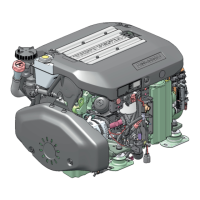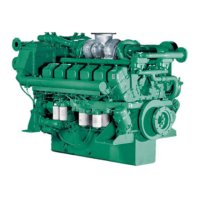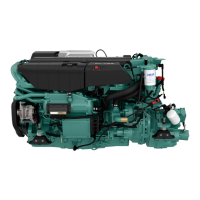Do you have a question about the Volvo Penta D3-130A-A and is the answer not in the manual?
Explains how safety information is presented in the manual and on the engine.
Lists essential safety measures to follow while operating the boat.
Details safety guidelines for performing engine and equipment maintenance and service.
Discusses environmental responsibility and advice on fuel/oils and running-in.
Covers importance of service, genuine parts, certified engines, and warranty coverage.
Details on locating and recording engine and transmission identification numbers.
Details engine block, mounting, lubrication, fuel, cooling, electrical systems, and instrumentation.
Explains the EVC system, its components, operation, and benefits for safety and data.
Describes gauges like Tachometer, Voltmeter, Temp, Fuel, Speed, Trim, and ignition switch.
Details warning lamps, their indications (red/yellow), and audible alarms.
Describes the Tachometer/LCD Gauge and Button Panel for EVC system interaction.
Diagram of EVC menu flow: Main, Trip, Gauges, Settings.
Explains Depth, Water Temp, Engine Hours, Fuel Rate, and Fuel Economy screens.
Details Average Fuel Rate, Average Fuel Economy, Trip Time, Distance, and Fuel displays.
Describes Gauge readings and Settings for alarms, units, brightness, and contrast.
Explains maneuvering using the single lever control for forward, neutral, and reverse.
Details disengaging the shift function and adjusting the control lever's friction brake.
Explains how to use Power Trim to adjust drive angle for optimal boat handling.
Describes Trim ranges (Beach, Lift) and instruments for displaying drive angle.
Emphasizes visual checks, EVC startup, and warming the engine before use.
Step-by-step guide for starting the engine using the ignition switch and lever.
Advises on reading instruments and safe operation of engine and controls.
Details proper shifting, recommended cruising speeds, and using Power Trim.
Explains operating in Trim range, fuel economy, and alarm responses.
Guidance on beach range use, fuel economy, and procedures for running aground.
Steps for safely stopping the engine and performing post-stop inspections.
Measures for preventing freezing, storing the boat, and transporting it on a trailer.
Guides for jump-starting with auxiliary batteries and manual emergency shifting.
Identifies water in fuel, provides fault-tracing table, and diagnostic function overview.
Explains diagnostic functions, malfunction messages, and LCD alarm warnings.
Covers daily, 14-day, 50-hr, 200-hr, 600-hr, 1200-hr, and 1400-hr service intervals.
Routine visual inspection of the engine and engine room for leaks, loose parts, and wear.
Covers air filter changes, exhaust line checks, and lubrication system oil/filter changes.
Details procedures for maintaining the freshwater and seawater cooling systems.
Explains fuel filter changes, bleeding the fuel system, and pre-filter maintenance.
Covers main switch, fuses, electrical connections, and battery maintenance.
Procedure for checking reverse gear oil level and changing oil/filter.
Instructions for venting, lubricating the propeller shaft seal, and its service intervals.
Explains paint, anodes, ground braids, and anode maintenance for corrosion protection.
Covers checking lubricant levels and filling SX and DP-S drive units.
Instructions for checking drive bellows, lubricating CV joints and primary shaft bearings.
Adjustment guidance for twin units and trim fin setting for SX drives.
Detailed steps for checking, replacing, and cleaning anodes on the XDP drive.
How to check lubricant levels and fill the XDP drive unit with synthetic gear oil.
Explains the components and operation of the power assisted steering system.
How to lubricate the steering ram and information on twin unit steering configurations.
Advice on selecting propellers, and step-by-step guide for removal and installation.
Procedures for preparing the boat for storage and bringing it out of storage.
Instructions for applying primer and antifouling paint to the drive and hull.
Explains the meaning of warning lamps, audible warnings, and text messages.
Details causes, reactions, and actions for common faults like coolant temp, depth, fuel level.
General information, lubrication, cooling, fuel, and drive unit specifications.
Details for Power Trim, Steering, Reverse Gears, and other system specifications.
Explains how safety information is presented in the manual and on the engine.
Lists essential safety measures to follow while operating the boat.
Details safety guidelines for performing engine and equipment maintenance and service.
Discusses environmental responsibility and advice on fuel/oils and running-in.
Covers importance of service, genuine parts, certified engines, and warranty coverage.
Details on locating and recording engine and transmission identification numbers.
Details engine block, mounting, lubrication, fuel, cooling, electrical systems, and instrumentation.
Explains the EVC system, its components, operation, and benefits for safety and data.
Describes gauges like Tachometer, Voltmeter, Temp, Fuel, Speed, Trim, and ignition switch.
Details warning lamps, their indications (red/yellow), and audible alarms.
Describes the Tachometer/LCD Gauge and Button Panel for EVC system interaction.
Diagram of EVC menu flow: Main, Trip, Gauges, Settings.
Explains Depth, Water Temp, Engine Hours, Fuel Rate, and Fuel Economy screens.
Details Average Fuel Rate, Average Fuel Economy, Trip Time, Distance, and Fuel displays.
Describes Gauge readings and Settings for alarms, units, brightness, and contrast.
Explains maneuvering using the single lever control for forward, neutral, and reverse.
Details disengaging the shift function and adjusting the control lever's friction brake.
Explains how to use Power Trim to adjust drive angle for optimal boat handling.
Describes Trim ranges (Beach, Lift) and instruments for displaying drive angle.
Emphasizes visual checks, EVC startup, and warming the engine before use.
Step-by-step guide for starting the engine using the ignition switch and lever.
Advises on reading instruments and safe operation of engine and controls.
Details proper shifting, recommended cruising speeds, and using Power Trim.
Explains operating in Trim range, fuel economy, and alarm responses.
Guidance on beach range use, fuel economy, and procedures for running aground.
Steps for safely stopping the engine and performing post-stop inspections.
Measures for preventing freezing, storing the boat, and transporting it on a trailer.
Guides for jump-starting with auxiliary batteries and manual emergency shifting.
Identifies water in fuel, provides fault-tracing table, and diagnostic function overview.
Explains diagnostic functions, malfunction messages, and LCD alarm warnings.
Covers daily, 14-day, 50-hr, 200-hr, 600-hr, 1200-hr, and 1400-hr service intervals.
Routine visual inspection of the engine and engine room for leaks, loose parts, and wear.
Covers air filter changes, exhaust line checks, and lubrication system oil/filter changes.
Details procedures for maintaining the freshwater and seawater cooling systems.
Explains fuel filter changes, bleeding the fuel system, and pre-filter maintenance.
Covers main switch, fuses, electrical connections, and battery maintenance.
Procedure for checking reverse gear oil level and changing oil/filter.
Instructions for venting, lubricating the propeller shaft seal, and its service intervals.
Explains paint, anodes, ground braids, and anode maintenance for corrosion protection.
Covers checking lubricant levels and filling SX and DP-S drive units.
Instructions for checking drive bellows, lubricating CV joints and primary shaft bearings.
Adjustment guidance for twin units and trim fin setting for SX drives.
Detailed steps for checking, replacing, and cleaning anodes on the XDP drive.
How to check lubricant levels and fill the XDP drive unit with synthetic gear oil.
Explains the components and operation of the power assisted steering system.
How to lubricate the steering ram and information on twin unit steering configurations.
Advice on selecting propellers, and step-by-step guide for removal and installation.
Procedures for preparing the boat for storage and bringing it out of storage.
Instructions for applying primer and antifouling paint to the drive and hull.
Explains the meaning of warning lamps, audible warnings, and text messages.
Details causes, reactions, and actions for common faults like coolant temp, depth, fuel level.
General information, lubrication, cooling, fuel, and drive unit specifications.
Details for Power Trim, Steering, Reverse Gears, and other system specifications.
| Brand | Volvo Penta |
|---|---|
| Model | D3-130A-A |
| Category | Engine |
| Language | English |











